JEDEC
STANDARD
Solid-State Drive (SSD) Requirements
and Endurance Test Method
JESD218A
(Revision of JESD218, September 2010)
FEBRUARY 2011
JEDEC SOLID STATE TECHNOLOGY ASSOCIATION
�
NOTICE
JEDEC standards and publications contain material that has been prepared, reviewed, and
approved through the JEDEC Board of Directors level and subsequently reviewed and approved
by the JEDEC legal counsel.
JEDEC standards and publications are designed to serve the public interest through eliminating
misunderstandings between manufacturers and purchasers, facilitating interchangeability and
improvement of products, and assisting the purchaser in selecting and obtaining with minimum
delay the proper product for use by those other than JEDEC members, whether the standard is to
be used either domestically or internationally.
JEDEC standards and publications are adopted without regard to whether or not their adoption
may involve patents or articles, materials, or processes. By such action JEDEC does not assume
any liability to any patent owner, nor does it assume any obligation whatever to parties adopting
the JEDEC standards or publications.
The information included in JEDEC standards and publications represents a sound approach to
product specification and application, principally from the solid state device manufacturer
viewpoint. Within the JEDEC organization there are procedures whereby a JEDEC standard or
publication may be further processed and ultimately become an ANSI standard.
No claims to be in conformance with this standard may be made unless all requirements stated in
the standard are met.
Inquiries, comments, and suggestions relative to the content of this JEDEC standard or
publication should be addressed to JEDEC at the address below, or call (703) 907-7559 or
©JEDEC Solid State Technology Association 2011
www.jedec.org
Published by
3103 North 10th Street
Suite 240 South
Arlington, VA 22201-2107
This document may be downloaded free of charge; however JEDEC retains the
copyright on this material. By downloading this file the individual agrees not to
charge for or resell the resulting material.
PRICE: Contact JEDEC
Printed in the U.S.A.
All rights reserved
�
PLEASE!
DON’T VIOLATE
THE
LAW!
This document is copyrighted by JEDEC and may not be
reproduced without permission.
Organizations may obtain permission to reproduce a limited number of copies
through entering into a license agreement. For information, contact:
JEDEC Solid State Technology Association
3103 North 10th Street
Suite 240 South
Arlington, VA 22201-2107
or call (703) 907-7559
�
�
SOLID STATE DRIVE (SSD) REQUIREMENTS AND ENDURANCE TEST METHOD
JEDEC Standard No. 218
Page 1
Cycling pool
Scope
(From JEDEC Board Ballot JCB-10-53, and JCB-10-92, formulated under the cognizance of the JC-64.8
Subcommittee on Solid State Drives.)
1
This standard defines JEDEC requirements for solid state drives. For each defined class of solid state
drive, the standard defines the conditions of use and the corresponding endurance verification
requirements. Although endurance is to be rated based upon the standard conditions of use for the class,
the standard also sets out requirements for possible additional use conditions as agreed to between
manufacturer and purchaser.
Qualification of a solid state drive involves many factors beyond endurance and retention, so such
qualification is beyond the scope of this standard, but this standard is sufficient for the endurance and
retention part of a drive qualification. This standard applies to individual products and also to
qualification families as defined in this standard.
The scope of this standard includes solid state drives based on solid-state non-volatile memory (NVM).
NAND Flash memory is the most common form on memory used in solid state drives at the time of this
writing, and this standard emphasizes certain features of NAND. The standard is also intended to apply
to other forms of NVM.
2
The revision of the referenced documents shall be that which is in effect on the date of the qualification
plan.
JESD22-A117, Electrically Erasable Programmable ROM (EEPROM) Program/Erase Endurance and
Data Retention Stress Test
JESD47, Stress-Test-Driven Qualification of Integrated Circuits
JEP122, Failure Mechanisms and Models for Semiconductor Devices
JESD219, Solid State Devices (SSD) Endurance Workloads
3
3.1
Erase blocks used by the SSD during read, write, or erase operations at a specific point in time.
NOTE The SSD may have additional erase blocks besides those in the current cycling pool that may be used as
spares or for other purposes. The cycling pool is typically larger than the user-accessible LBA count.
Terms, definitions, abbreviations, and technical background
Reference Documents
�
Data Error
Data Retention
Endurance
Endurance failure
Terms, definitions, abbreviations, and technical background (cont’d)
JEDEC Standard No. 218
Page 2
3
3.2
A type of failure in which the drive fails to return correct data to the host.
NOTE One data error occurs if a read of a logical sector causes the drive to return an unrecoverable error message
or to return incorrect data. Data errors are counted as such even if they are transient. See 7.1.2 for further
discussion of data errors.
3.3
The ability of the SSD to retain data over time. Synonymous with retention in this document.
3.4
The ability of an SSD to withstand multiple data rewrites.
3.5
A failure that is caused by endurance stressing.
NOTE 1 Endurance failures may be data error types or functional failure types, as described above.
NOTE 2
In an endurance stress, some failures may occur that are unrelated to endurance. For example, a solder
joint could fail. A failure is considered unrelated to endurance if it was not caused by the endurance stress itself
(i.e., if it was not caused by the repetitive writing of data to the drive). Such non-endurance failures are not
considered as part of endurance verification.
NOTE 3 A number of distinct failure mechanisms are responsible for endurance failures, and in general these are
accelerated in different ways by temperature and other adjustable qualification parameters. For example, in
floating-gate memories failure may be caused by charge trapping (normally accelerated by lower temperatures) in
the charge transfer dielectric or by oxide rupturing (normally accelerated by higher temperatures) in the transfer
dielectric or in peripheral dielectrics. For these reasons, endurance may depend on temperature but it is not known
a priori whether high temperature is worse than low temperature, or vice-versa.
3.6
The number of terabytes that may be written to the SSD such that the SSD meets the requirements defined
in 6.2.
NOTE Several factors impact the endurance rating including how optimally the wear leveling has been
implemented, write amplification factor and the cycling capability of the NAND components. The relationship
between TBW, write amplification factor and the wear-leveling efficiency are highly dependent on the workload
applied for the characterization of endurance.
3.7
The smallest addressable unit for erase operations, typically consisting of multiple pages.
Endurance Rating (TBW rating)
Erase block
�
JEDEC Standard No. 218
Page 3
Failure
Functional Failure
Functional Failure Requirement (FFR)
Terms, definitions, abbreviations, and technical background (cont’d)
3
3.8
The noncompliance of an SSD to the electrical or physical requirements specified for the device.
NOTE Failures may be permanent or transient. For the purpose of this standard, a permanent failure is an SSD
that fails sometime during a reliability stress and continues to fail at the final test at the end of that same stress. A
transient failure is an SSD that fails during a reliability stress but passes in the final test at the end of that stress.
3.9
A failed drive that fails to function properly in a way that is more severe than having a data error.
NOTE See 7.1.2 for discussion of functional failures.
3.10
The allowed cumulative functional failures over the TBW rating. See 6.3.
3.11 Gigabyte (GB)
Approximately equal to 109 bytes when used in reference to SSD capacity (see 4)
3.12 Host
The computer system, test system, or other device, which writes data to and reads data from the SSD.
3.13 Host writes
Data transmitted through the primary SSD interface to be written to the SSD.
3.14 Logical Block Address (LBA)
The logical address used to reference a data sector (block) in the drive.
NOTE 1 LBA is synonymous with the data sector itself.
NOTE 2 Block in the drive is a logical construct separate from that of an erase block in the NVM.
3.15 Non-Volatile Memory (NVM)
A memory which retains data after the power is turned off.
NOTE The non-volatile memories considered in this standard are capable of being electrically rewritten.
�
Page
Program/erase cycle (p/e cycle)
Terms, definitions, abbreviations, and technical background (cont’d)
JEDEC Standard No. 218
Page 4
3
3.16
A sub-unit of an erase block consisting of a number of bytes which can be read from and written to in
single operations, through the loading or unloading of a page buffer and the issuance of a program or read
command.
3.17
The writing of data to one or more pages in an erase block and the erasure of that block, in either order.
3.18 Qualification Family
A group of SSD products which differ only in storage capacity and in minor design details that are
directly related to the capacity differences.
NOTE To be considered part of the same qualification family, SSD products must use the same nonvolatile
memory products, or different nonvolatile memory products that are themselves part of the same component
qualification family (defined in JESD47). The SSD products must also use the same controller and the same
firmware, except to the extent that the firmware requires different settings to support the different capacities of the
drives. The SSD products must also have the same ratio of TBW specification to capacity; for example, a 100 GB
drive with a 100 TBW specification could be in the same family as a 50 GB drive with a 50 TBW specification. Due
to the complexity of SSD designs, it is beyond the scope of this specification to completely define what constitutes a
qualification family. The burden of proof falls upon the SSD manufacturer who chooses to use the qualification
family concept.
3.19 Retention failure
A data error occurring when the SSD is read after an extended period of time following the previous
write.
NOTE A number of distinct failure mechanisms are responsible for retention failures, and in general these are
accelerated in different ways by temperature and other adjustable qualification parameters. For example, in
floating-gate memories, failure may occur due to defects that allow charge to leak through the transfer dielectric or
by the detrapping of charge in the transfer dielectric; the former can be weakly accelerated or even decelerated by
high temperature, and the latter can be highly temperature accelerated (see JEP122). For these reasons, retention
may depend on temperature but it is not known a priori whether high temperature is worse than low temperature, or
vice-versa.
3.20
A solid state drive (SSD) is a non-volatile storage device. A controller is included in the device with one
or more solid state memory components. The device should use traditional hard disk drive (HDD)
interfaces (protocol and physical) and form factors
3.21 Terabyte (TB)
For the purpose of this standard, a terabyte is equal to 1⋅1012 bytes.
Solid State Drive (SSD)
�
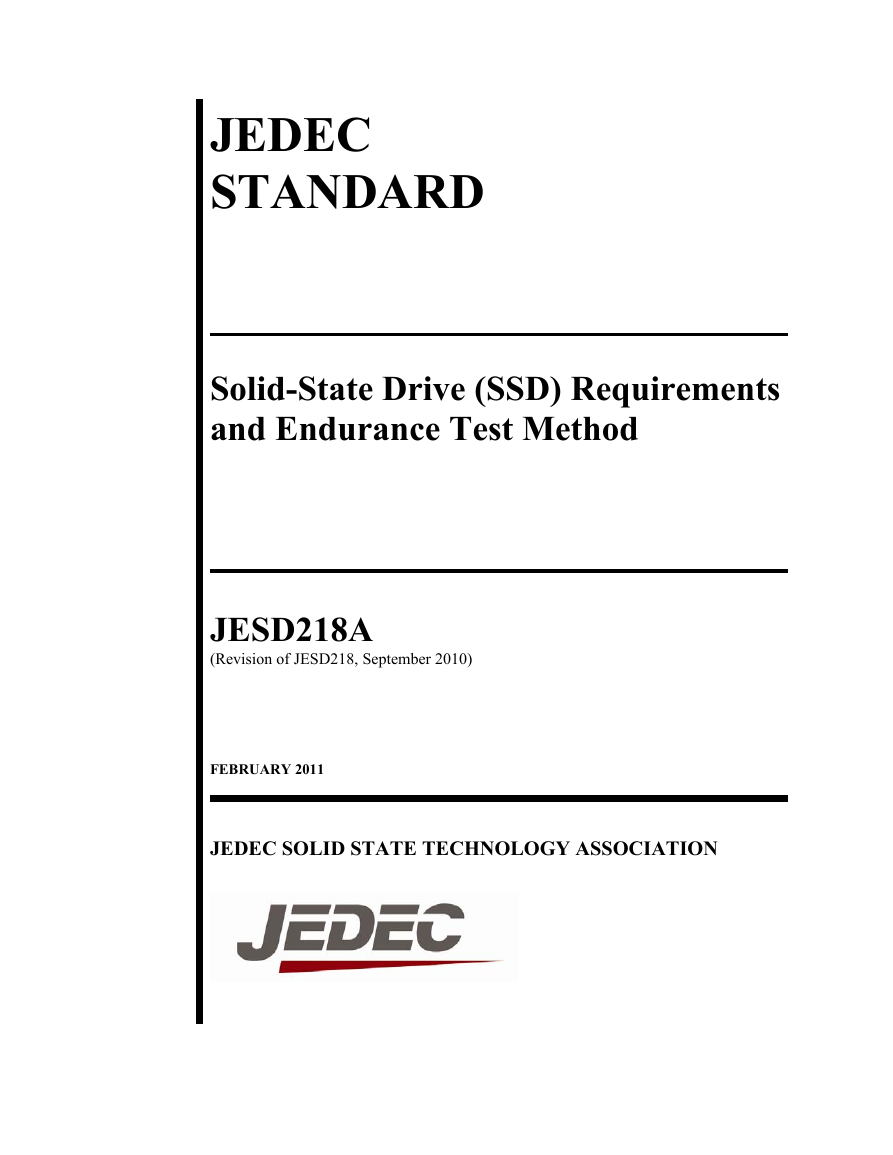
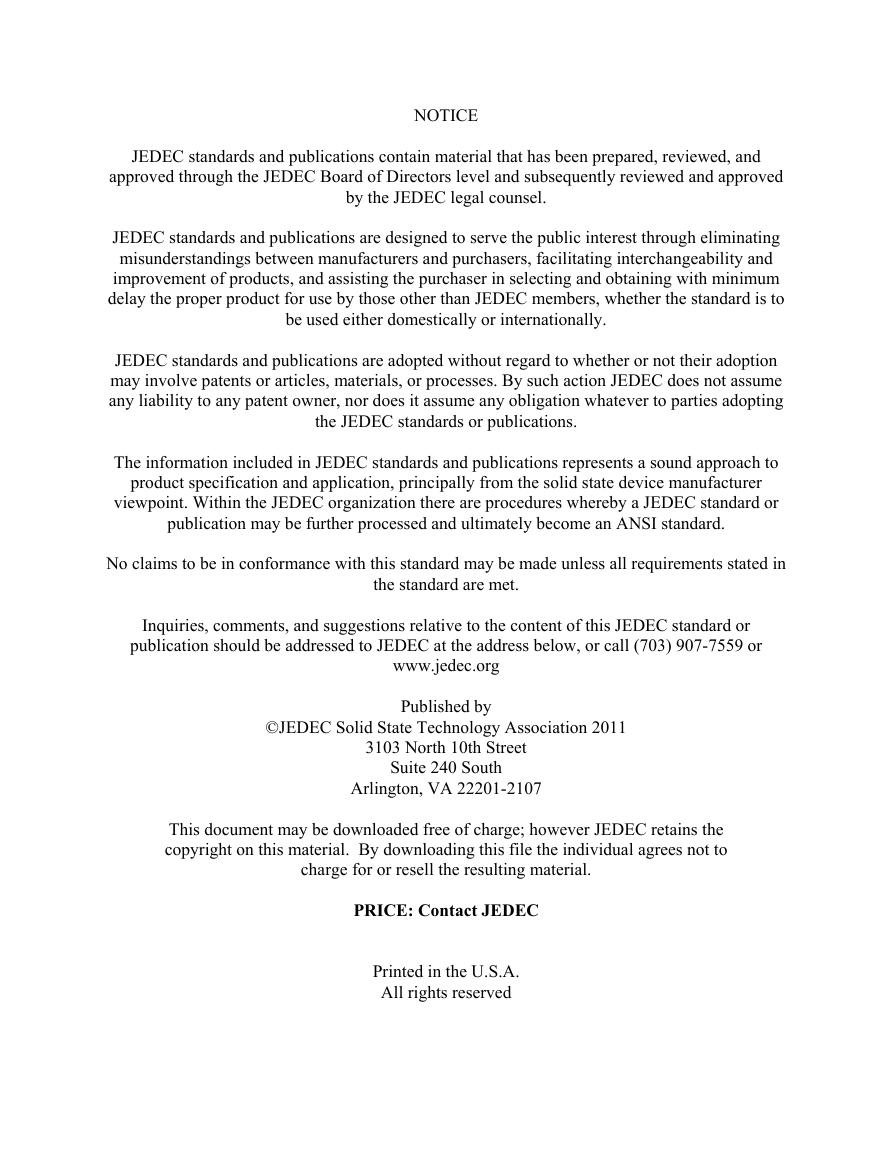
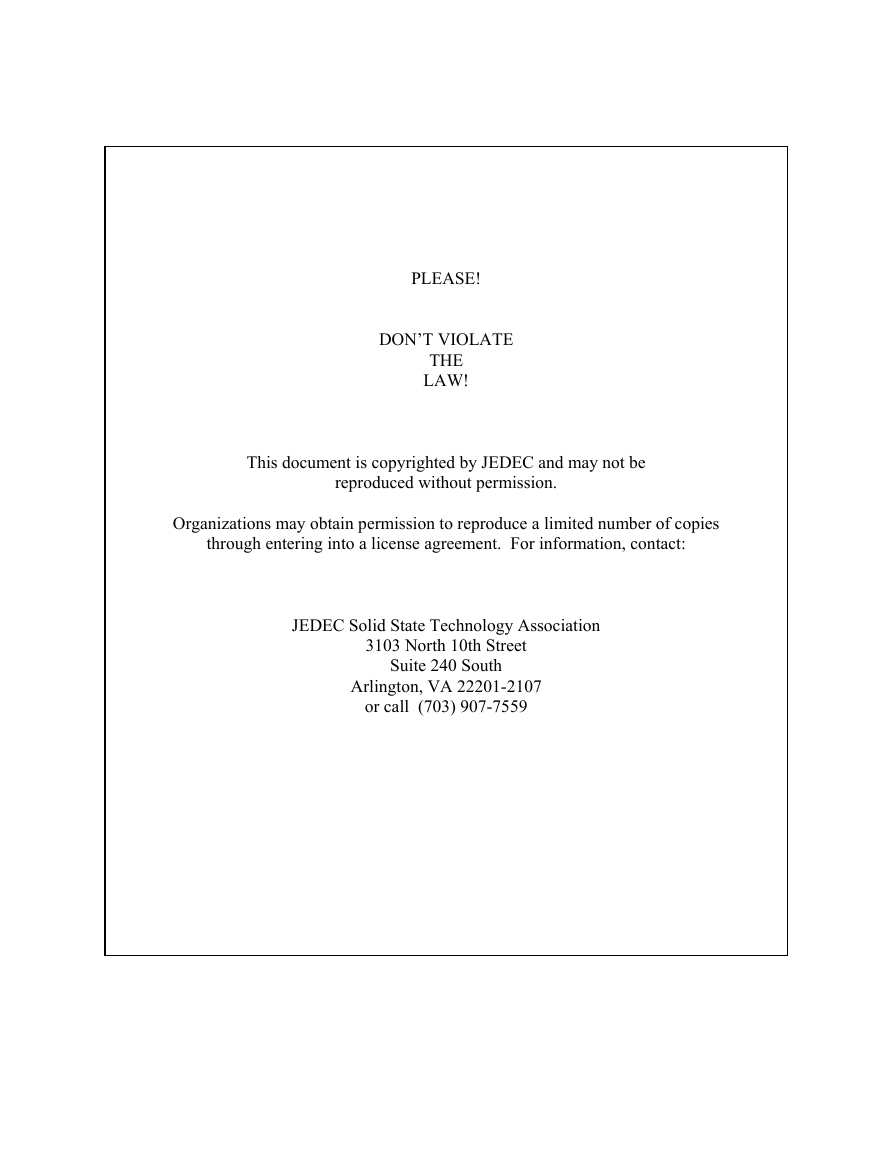

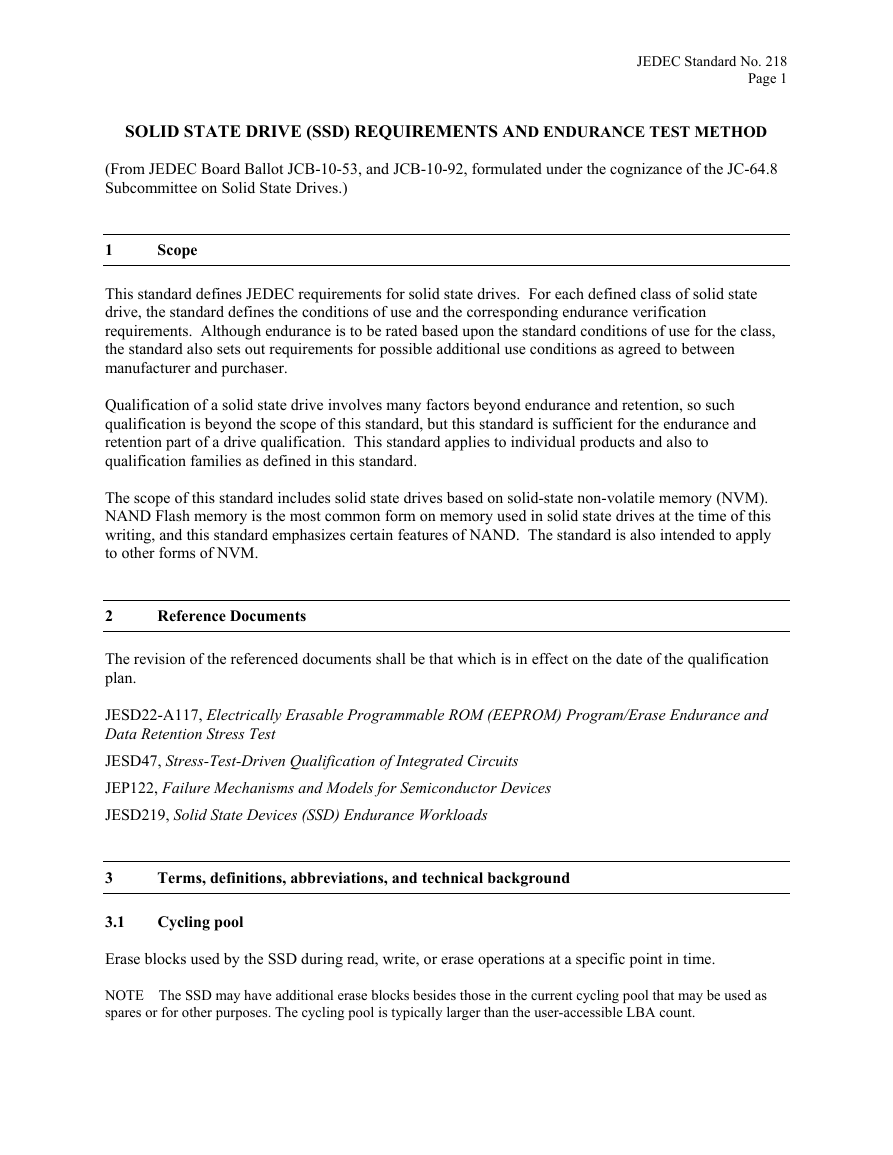
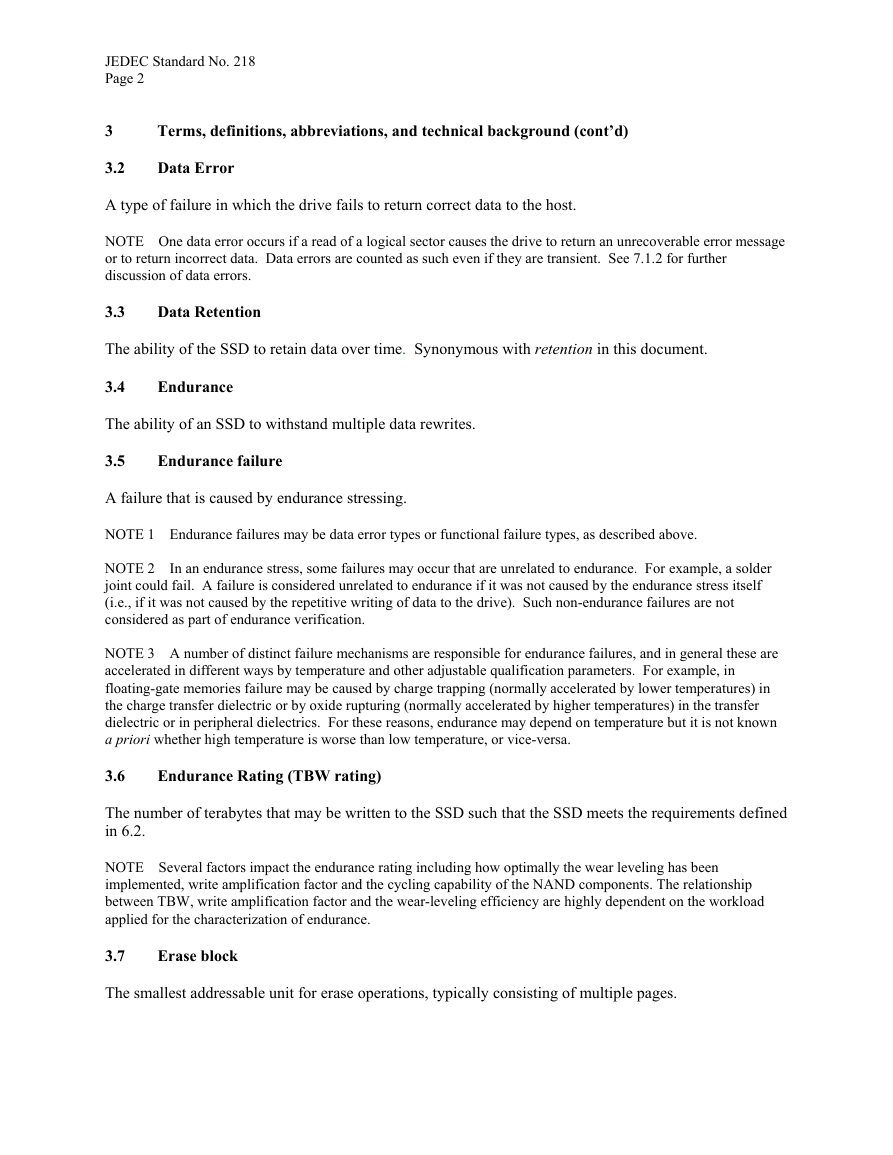










 2023年江西萍乡中考道德与法治真题及答案.doc
2023年江西萍乡中考道德与法治真题及答案.doc 2012年重庆南川中考生物真题及答案.doc
2012年重庆南川中考生物真题及答案.doc 2013年江西师范大学地理学综合及文艺理论基础考研真题.doc
2013年江西师范大学地理学综合及文艺理论基础考研真题.doc 2020年四川甘孜小升初语文真题及答案I卷.doc
2020年四川甘孜小升初语文真题及答案I卷.doc 2020年注册岩土工程师专业基础考试真题及答案.doc
2020年注册岩土工程师专业基础考试真题及答案.doc 2023-2024学年福建省厦门市九年级上学期数学月考试题及答案.doc
2023-2024学年福建省厦门市九年级上学期数学月考试题及答案.doc 2021-2022学年辽宁省沈阳市大东区九年级上学期语文期末试题及答案.doc
2021-2022学年辽宁省沈阳市大东区九年级上学期语文期末试题及答案.doc 2022-2023学年北京东城区初三第一学期物理期末试卷及答案.doc
2022-2023学年北京东城区初三第一学期物理期末试卷及答案.doc 2018上半年江西教师资格初中地理学科知识与教学能力真题及答案.doc
2018上半年江西教师资格初中地理学科知识与教学能力真题及答案.doc 2012年河北国家公务员申论考试真题及答案-省级.doc
2012年河北国家公务员申论考试真题及答案-省级.doc 2020-2021学年江苏省扬州市江都区邵樊片九年级上学期数学第一次质量检测试题及答案.doc
2020-2021学年江苏省扬州市江都区邵樊片九年级上学期数学第一次质量检测试题及答案.doc 2022下半年黑龙江教师资格证中学综合素质真题及答案.doc
2022下半年黑龙江教师资格证中学综合素质真题及答案.doc